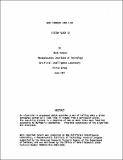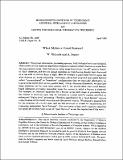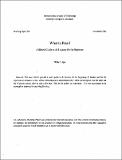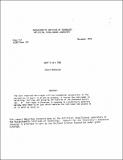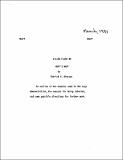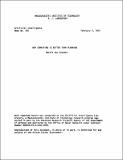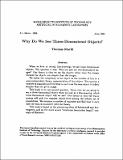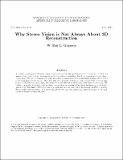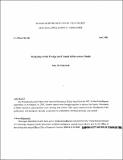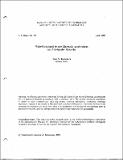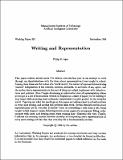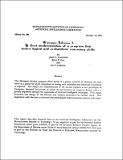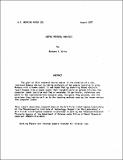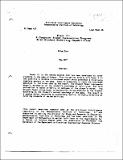Browsing Artificial Intelligence Lab Publications by Title
Now showing items 1809-1828 of 1835
-
What Are Plans For?
(1989-10-01)What plans are like depends on how they're used. We contrast two views of plan use. On the plan-as-program-view, plan use is the execution of an effective procedure. On the plan-as-communication view, plan use is like ... -
What Corners Look Like
(MIT Artificial Intelligence Laboratory, 1971-06)An algorithm is presented which provides a way of telling what a given trihedral corner will look like if viewed from a particular angle. The resulting picture is a junction of two or more lines each labelled according to ... -
What is Delaying the Manipulator Revolution?
(MIT Artificial Intelligence Laboratory, 1978-02)Despite two decades of work on mechanical manipulators and their associated controls, we do not see wide-spread application of these devices to many of the tasks to which they seem so obviously suited. Somehow, a variety ... -
What Makes a Good Feature?
(1992-04-01)Using a Bayesian framework, we place bounds on just what features are worth computing if inferences about the world properties are to be made from image data. Previously others have proposed that useful features reflect ... -
What to Read: A Biased Guide to AI Literacy for the Beginner
(MIT Artificial Intelligence Laboratory, 1972-11)This note tries to provide a quick guide to AI literacy for the beginning AI hacker and for the experienced AI hacker or two whose scholarship isn't what it should be. most will recognize it as the same old list of classic ... -
What's in a Tune
(1974-11-01)The work reported here began with two fundamental assumptions: 1) The perception of music is an active process; it involves the individual in selecting, sorting, and grouping the features of the phenomena before her. ... -
What's What
(MIT Artificial Intelligence Laboratory, 1971-03)An outline of the modules used in the copy demonstration, the reasons for doing robotics, and some possible directions for further work. -
Why are There so Few Female Computer Scientists?
(1991-08-01)This report examines why women pursue careers in computer science and related fields far less frequently than men do. In 1990, only 13% of PhDs in computer science went to women, and only 7.8% of computer science ... -
Why Conniving is Better than Planning
(1972-02-01)A higher level language derives its great power form the fact that it tends to impose structure on the problem solving behavior for the user. Besides providing a library of useful subroutines with a uniform calling ... -
Why Conniving is Better than Plannng
(1972-04-01)This paper is a critique of a computer programming language, Carl Hewitts PLANNER, a formalism designed especially to cope with the problems that Artificial Intelligence encounters. It is our contention that the ... -
Why Do We See Three-dimensional Objects?
(1992-06-01)When we look at certain line-drawings, we see three-dimensional objects. The question is why; why not just see two-dimensional images? We theorize that we see objects rather than images because the objects we see are, ... -
Why Stereo Vision is Not Always About 3D Reconstruction
(1993-07-01)It is commonly assumed that the goal of stereovision is computing explicit 3D scene reconstructions. We show that very accurate camera calibration is needed to support this, and that such accurate calibration is difficult ... -
WIRElist
(1969-01-01)This memo describes a design aid used for the automatic production of wirelists for machine or hand wiring of wire-cards. -
Workshop on the Design and Control of Dextrous Hands
(1982-04-01)The Workshop for the Design and Control of Dexterous Hands was held at the MIT Artificial Intelligence Laboratory on November 5-6, 1981. Outside experts were brought together to discuss four topics: kinematics of hands, ... -
Worms of Ganymedes - Hazards of Image "Restoration"
(MIT Artificial Intelligence Laboratory, 1980-09) -
Wrist-Partitioned Inverse Kinematic Accelerations and Manipulator Dynamics
(1983-04-01)An efficient algorithm is presented for the calculation of the inverse kinematic accelerations for a 6 degree-of-freedom manipulator with a spherical wrist. The inverse kinematic calculation is shown to work synergistically ... -
Writing and Representation
(MIT Artificial Intelligence Laboratory, 1988-09)This paper collects several notes I've written over the last year in an attempt to work through my dissatisfactions with the ideas about representation I was taught in school. Among these ideas are the notion of a 'world ... -
Wumpus Advisor 1: A First Implementation Program that Tutors Logical and Probabilistic Reasoning Skills
(1976-10-01)The Wumpus Advisor program offers advice to a player involved in choosing the best move in a game for which competence in dealing with incomplete and uncertain knowledge is required. The design and implementation of ... -
Wumpus Protocol Analysis
(MIT Artificial Intelligence Laboratory, 1977-08)The goal of this research was to assist in the creation of a new, improved Wumpus advisor by taking protocols of ten people learning to play Wumpus with a human coach. It was hoped that by observing these subjects learn ... -
Wusor II: A Computer Aided Instruction Program with Student Modelling Capabilities
(1977-05-01)Wusor II is the second program that has been developed to tutor students in the game of Wumpus. From the earlier efforts with Wusor I it was possible to produce a rule-based expert which processed a relatively complete ...


